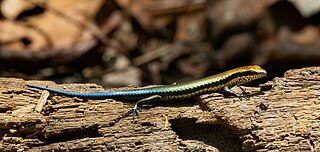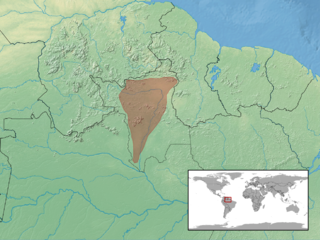
Skinks are lizards belonging to the family Scincidae, a family in the infraorder Scincomorpha. With more than 1,500 described species across 100 different taxonomic genera, the family Scincidae is one of the most diverse families of lizards. Skinks are characterized by their smaller legs in comparison to typical lizards and are found in different habitats except arctic and subarctic regions.

The Florida sand skink is a species of lizard in the family Scincidae, the skinks. It is endemic to Florida in the United States.
Carinascincus palfreymani, known commonly as the Pedra Branca skink, as well as the Palfreyman's window-eyed skink, the Pedra Branca cool-skink, or the red-throated skink, is a species of skink in the family Scincidae. The species is endemic to Australia, and is restricted to the windswept Pedra Branca, an island off southern Tasmania of only 2.5 ha, where it is dependent on the seabird colonies. It is the only lizard species found on the island.
Aromobates meridensis is a species of frog in the family Aromobatidae. It is endemic to the Cordillera de Mérida near Chorotal, Venezuela.

Carinascincus metallicus, the metallic cool-skink or metallic skink is a species of skink in the family Scincidae. It is endemic to Australia, found in southern Victoria, as well as in Tasmania where it is the most widespread and common lizard, occurring on many offshore islands in Bass Strait as well as the mainland. It gives birth to live young. It is highly variable in colour and pattern, and may be a complex of closely related species.
Nephelomys caracolus, also known as the Costa Central oryzomys or caracol rice rat, is a species of rodent in the genus Nephelomys of family Cricetidae. It is found in cloud forest in the Cordillera de la Costa Central of Aragua, Miranda, and the Distrito Federal in north-central Venezuela at elevations from 1000 to 2500 m. It is nocturnal and terrestrial, and has a varied diet. In most Nephelomys species, the posterolateral palatal pits, perforations of the palate near the third molar, are conspicuous and receded into a fossa, but in N. caracolus and the Ecuadorian species N. nimbosus, the pits are much smaller.
Nephelomys meridensis, also known as the Mérida oryzomys, is a species of rodent in the genus Nephelomys of family Cricetidae. It is found in cloud forest in the Sierra Nevada de Mérida of western Venezuela at elevations from 1100 to 4000 m. It is solitary, nocturnal and terrestrial, and has a varied diet.

The Greater Martinique skink is a species of skink found on Martinique. It has shiny, bronze-colored skin, with a pair of light stripes that run along its upper flanks.

Copeoglossum nigropunctatum, also known as the black-spotted skink, common coppery mabuya, or South American spotted skink, is a species of skink found in South America. It has shiny bronze or copper skin, with a dark longitudinal stripe along each flank that is often bordered by cream-colored lines.

The eastern mountain coati or eastern dwarf coati is a small procyonid found in cloud forest and páramo at elevations of 2,000–4,000 m (6,600–13,100 ft) in the Andes of western Venezuela. Until 2009, it was included as a subspecies of the western mountain coati, but the eastern mountain coati is overall smaller, somewhat shorter-tailed on average, has markedly smaller teeth, a paler olive-brown pelage, and usually a dark mid-dorsal stripe on the back versus more rufescent or blackish, and usually without a dark mid-dorsal stripe in the western mountain coati. When the two were combined, they were classified as Data Deficient on the IUCN Red List but following the split the eastern mountain coati is considered endangered. A genetic analysis revealed that it should be regarded as a synonym of N. olivacea.

The four-toed earless skink, also known commonly as Péron's earless skink, the lowlands earless skink, or the four-toed mulch skink, is a viviparous earless skink endemic to southern Australia.
The Venezuelan mountain skink is a reptile, a member of the skink family, Scincidae. It is monotypic in the genus Orosaura.
Maracaiba is a genus of skinks.
The Margarita skink is a species of skink found on Margarita Island in Venezuela.
Maracaiba zuliae is a species of skink, a lizard in the family Scincidae. The species is native to northwestern South America.
Marisora falconensis is a species of skink found in Venezuela and Colombia.

Carvalho's mabuya is a species of skink, a lizard in the family Scincidae. The species is native to northern South America.
Horton's mabuya is a species of skink, a lizard in the family Scincidae. The species is endemic to Venezuela.
Atractus meridensis is a species of snake in the family Colubridae. The species can be found in Venezuela.

Micrurus meridensis, the Merida coral snake, is a species of snake of the family Elapidae.









